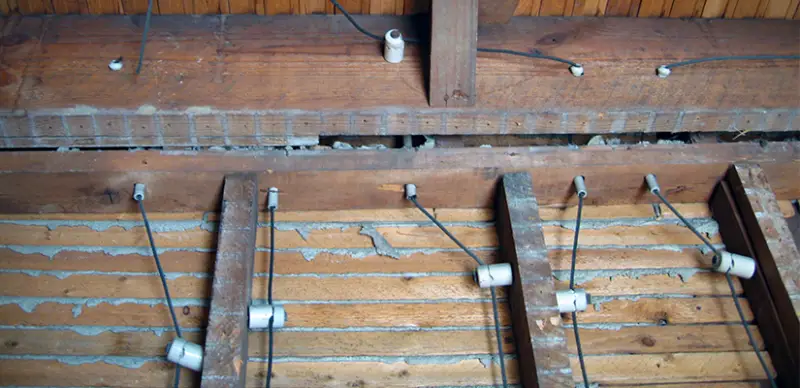
Mr. Electric® explains how to identify and address knob and tube wiring.
|
If you're living in a home built before the 1950s—or even the 1970s—you might have outdated knob and tube electrical components inside your walls. These open-wire systems were standard in residential structures in the past, but have since become obsolete. In this guide, we’ll explain what knob and tube wiring is, how to identify it, potential safety risks, and what to do if your home still uses this aging setup.
What Is Knob and Tube Wiring?
Knob and tube wiring, often abbreviated as K&T, is an early method of electrical wiring commonly used in homes built between the early 1900s and the 1950s. It gets its name from the ceramic knobs that hold wires in place and the tubes that protect the wires as they pass through wooden joists or studs.
This system was innovative for its time, offering a way to route wires through homes before modern electrical codes and standards existed. However, due to its age, knob and tube wiring is no longer compatible with today’s energy demands, and it can pose significant safety risks.
How to Identify Knob and Tube Electrical Wiring

Do you think your home might still have this wiring? Here’s how to spot knob and tube electrical components:
- Ceramic knobs nailed into floor joists or studs with wires threaded through
- White or black cloth-wrapped wires (often brittle or frayed)
- Wires suspended in air, not run through conduit or sheathing
- No ground wires inside your outlets or switch boxes
Unfortunately, it's not uncommon for knob and tube wiring to be hidden in the walls. In this case, it can only be identified by visual inspection, either by cutting holes in the walls or by means of a camera probe.
If you see any of the signs above or you suspect your home has hidden knob and tube wiring, contact a qualified electrician for a reliable assessment.
Is Knob and Tube Electrical Wiring Safe?
Although knob and tube electrical wiring was considered safe many decades ago, it's now considered obsolete and potentially dangerous. Here’s why it no longer makes the cut:
1. No grounding wire
Modern electrical systems have a grounding wire that safely directs excess electricity away from devices and people. K&T wiring doesn’t. This makes it incompatible with three-prong outlets and increases the risk of shock and fire.
If you live in or are considering purchasing an older home without three-prong outlets, take some time to learn why two-prong outlets are not up to code.
2. Insulation deterioration
K&T wires are insulated with rubberized cloth. This wrapping breaks down over time—especially in attics or warm areas—exposing bare wires and increasing fire risk.
3. Overloaded circuits
Homes built in the early 1900s weren't designed for modern-day usage (think TVs, microwaves, and smart home tech). K&T wiring simply can’t handle today’s electrical loads.
4. Spliced modifications
Electricians or DIYers may have improperly spliced modern wiring into older K&T circuits, creating serious fire and code compliance issues.
5. Insurance red flags
Insurance companies may charge a premium for homes with knob and tube wiring or refuse to insure them altogether.
If you’re considering purchasing an older home or weighing whether to modernize your electrical system, make sure you’re familiar with the potential risks of knob and tube wiring.
How to Replace Knob and Tube Wiring
If your home still runs on knob and tube wiring, a full or partial rewire is highly recommended. Replacing knob and tube electrical wiring ensures your home meets modern safety standards, reduces fire risks, and protects your electronics. It also gives you the ability to install grounded outlets, USB receptacles, smart switches, and more.
What to Expect During a Rewire
Replacing knob and tube wiring isn’t a quick DIY project—it requires careful planning and execution by a qualified electrician. Here’s what the process typically involves:
- Electrical inspection: Your electrician will locate all K&T wiring, inspect junctions, and evaluate electrical load needs.
- Permits & code review: You’ll likely need permits, especially if you’re upgrading the panel or modifying circuits.
- Removal & replacement: New wires are installed through walls, floors, or attic spaces using modern sheathed cables.
- Outlet & switch upgrades: Old two-prong outlets will be replaced with grounded three-prong options.
- Panel update (if needed): Your main panel may also be upgraded to accommodate new circuits.
Why You Should Never DIY Knob and Tube Replacements
Tampering with knob and tube electrical wiring is hazardous and can lead to code violations, electrical fires, or serious injury. Many older homes have multiple generations of wiring, some of which may be improperly spliced.
This is a job for the professionals. Let a licensed electrician handle the inspection, replacement, and cleanup to ensure your home’s electrical system is compliant and compatible with modern codes.
Don’t Let Old Wiring Hold You Back
Knob and tube wiring may have once been state-of-the-art, but it’s far from safe by today’s standards. From insurance issues to electrical fires, it has the potential to cause serious property damage and personal harm. If your home still relies on a knob and tube electrical system, it’s time for a modern solution.
Whether you’re renovating, purchasing, or just looking for peace of mind, Mr. Electric is here to help. Our professionals can inspect, rewire, and modernize your system while keeping your home safe and code-compliant.
To learn more about knob and tube wiring and all of our services, visit our extensive FAQ page or request an appointment today.
This article is intended for general guidance only and is not applicable to every situation. You are responsible for determining the proper course of action for your property and situation. Mr. Electric is not responsible for any damages that occur as a result of advice and/or guidance derived from its blog content.
FAQs About Knob and Tube Wiring
The safety of you, your family, and your home are the top priority of every Mr. Electric service professional. Our safety-first commitment to solving your electrical issues includes a meticulous attention to detail on every job. Our commitment also includes using our years of experience to answer your questions. Below are answers to some of the most frequently asked questions about knob and tube wiring.
How do I know if my home has knob and tube wiring?
Knob and tube wiring is often routed along beams and joists in attics or basements. Look for ceramic knobs (small, round ceramic insulators) securing the wires to beams or studs, and tubes (ceramic or metal) that protect the wires.
While visual inspection is the simplest way to identify K&T wiring, it may not be sufficient if the wires have been concealed within walls. If you’re not sure, check your electrical panel. Knob and tube wiring often lacks grounding, so if your electrical panel does not have modern circuit breakers, or your home lacks GFCI outlets, your system may have outdated wiring.
If you have any doubts about whether your home uses knob and tube wiring, contact a professional electrician.
Is knob and tube electrical wiring dangerous?
Yes, knob and tube wiring poses serious risks of electric shock and fire. As an outdated system, K&T wiring lacks grounding, an essential safety feature of modern electrical systems. It also features delicate insulation that degrades over time, leaving live wires exposed. Finally, many K&T systems have been poorly modified over the decades, resulting in non-compliant wiring.
Can a home with knob and tube wiring be insured?
Many insurance companies will either charge higher premiums or deny coverage entirely for homes with knob and tube electrical systems. Replacing the system often restores insurability and can improve your resale value.
Can I upgrade outlets without replacing knob and tube wiring?
Not safely. Adding modern three-prong outlets to ungrounded K&T systems is dangerous and against code in many areas. Always consult a professional electrician before making outlet upgrades in homes with knob and tube electrical wiring.
Is knob and tube wiring legal?
Knob and tube wiring is still legal, but that doesn’t mean it’s safe or advisable. If you’re planning to remodel or sell your home, replacing knob and tube electrical components will likely be crucial.
While building codes may not require immediate K&T removal, other factors make upgrading a smart decision:
- Knob and tube wiring does not meet modern electrical standards.
- Contractors (such as insulation installers) may refuse to work around outdated wiring.
- K&T wiring may disqualify the home for homeowner’s insurance or resale inspections.

